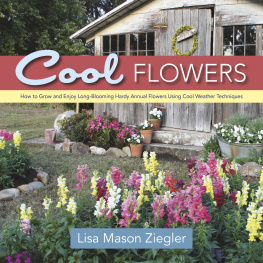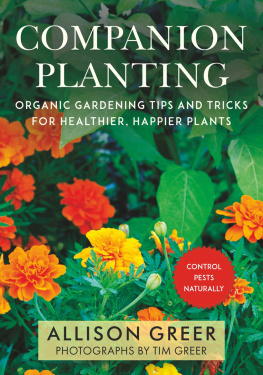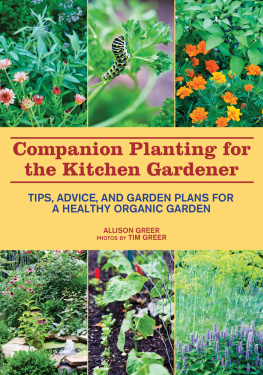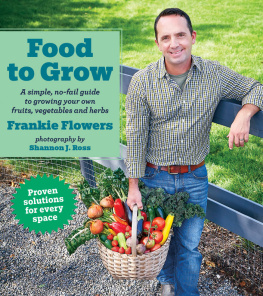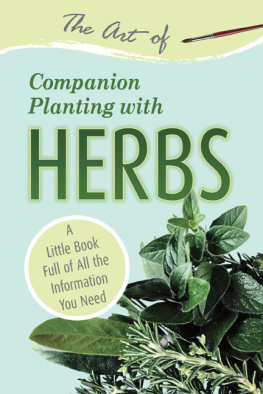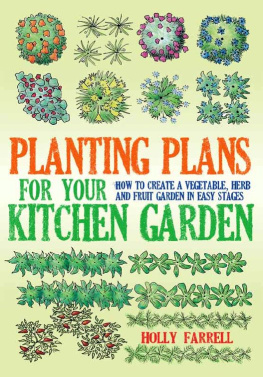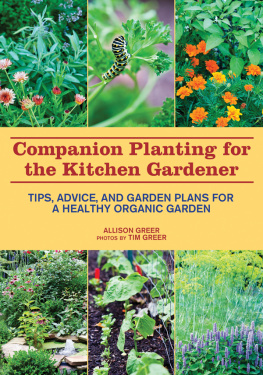
VEGETABLES LOVE FLOWERS
COMPANION PLANTING FOR BEAUTY AND BOUNTY
Lisa Mason Ziegler


2018 Quarto Publishing Group USA Inc. Text 2018 Lisa Ziegler
Photography by Bob Schamerhorn, except where otherwise noted.
First published in 2018 by Cool Springs Press, an imprint of The Quarto Group, 401 Second Avenue North, Suite 310, Minneapolis, MN 55401 USA. T (612) 344-8100 F (612) 344-8692 www.QuartoKnows.com
All rights reserved. No part of this book may be reproduced in any form without written permission of the copyright owners. All images in this book have been reproduced with the knowledge and prior consent of the artists concerned, and no responsibility is accepted by producer, publisher, or printer for any infringement of copyright or otherwise, arising from the contents of this publication. Every effort has been made to ensure that credits accurately comply with information supplied. We apologize for any inaccuracies that may have occurred and will resolve inaccurate or missing information in a subsequent reprinting of the book.
Cool Springs Press titles are also available at discount for retail, wholesale, promotional, and bulk purchase. For details, contact the Special Sales Manager by email at or by mail at The Quarto Group, Attn: Special Sales Manager, 401 Second Avenue North, Suite 310, Minneapolis, MN 55401 USA.
Digital edition: 978-0-76036-356-0
Softcover edition: 978-0-76035-758-3
Library of Congress Cataloging-in-Publication Data
Names: Ziegler, Lisa Mason, author.
Title: Vegetables love flowers : companion planting for beauty and bounty / Lisa Mason Ziegler.
Description: Minneapolis, MN : Cool Springs Press, 2018. | Includes index.
Identifiers: LCCN 2017043293 | ISBN 9780760363560 (sc)
Subjects: LCSH: Companion planting. | Vegetables. | Flowers.
Classification: LCC SB453.6 .Z54 2018 | DDC 635dc23
LC record available at https://lccn.loc.gov/2017043293
Acquiring Editors: Mark Johanson and Madeleine Vasaly
Project Manager: Alyssa Lochner
Art Director: Cindy Samargia Laun
Cover and Interior Design: Amy Sly
To my little sis and best friend, Suzanne.
I love that we do this together.
Introduction
It All Comes Down to Flowers
A summer harvest. Clockwise from top left: celosia Chief; black-eyed Susan Triloba; zinnia Benarys Giant; tomatoes Black Cherry, Cherokee Purple, and Big Beef; and Mexican sunflowers.
What business do pretty flowers have in a vegetable garden? Not much, many gardeners might thinkin fact, I married into a large vegetable-gardening family, and thats what they thought too. Flowers were a waste of precious space and labor in the vegetable patch. Treated like tagalong little sisters, they got a place only if there was room leftover. But all that changed with the discoveries I made on the way to becoming a cut-flower farmer.
Flowers have been a key element of the vegetable patch for centuries. The cottage garden is one example of the practical use of small-space gardening to grow food crops, with a healthy dose of flowers on the side to attract pollinators and beneficial insects. Today, flowers are often a casualty of downsizing and practicality, but in fact, flowers more than pull their weight in the garden! Ornamental and functional at the same time, they put out the welcome mat for pollinators and beneficial insects. The guests will come, set up house, and raise their familiesexactly what you need in a healthy garden.
After years of gardening and farming, visiting countless gardens planted by others, and fielding thousands of questions, there is one thing I have seen time and time again: allowing nature to provide the pest control, pollination, and nutritional systems in our gardens is so basic that we dont even think about it. It just seems too simple to work. But work it does when we give it some flowers and a chance.
Everything began to change in my garden when I added three seasons of pesticide-free flowers. Through the years, as I coupled the presence of flowers in the vegetable garden with common-sense natural gardening practices, my garden flourished. What rose above any gardening troubles along the way was that my garden filled up with pollinators and natures pest controlsespecially welcome at a time when the number of beneficial insects in most gardens, especially bees, has been diminished by pesticide exposure and loss of habitat. Gardening became easier and my harvests more abundant.
The practice of keeping a small cut-flower garden within the vegetable garden is nothing short of delightful. The gardener gets an armload of beautiful fresh-cut flowers each week, and the beneficial creatures are attracted to and happy with the continuous supply of new blossoms. Those beneficial creatures come for the flowers, then share their benefits with the nearby vegetables. The routine of harvesting the flowers for the table keeps the cutting garden alive and producing. This in turn keeps the garden full of fresh flowers for all. Just as we harvest the vegetable garden to keep it producing, we do the same with flowers.
I didnt set out to fill my gardens with pollinators, beneficial insects, and other good things. You might say they all came as a welcome side effect of all-natural cut-flower farming. I finally gave up messing with the ecosystem and instead gave it a hand up and helped it along. The result was a garden teeming with beautiful healthy plants producing abundance with little intervention from me, a garden just the way it was meant to be.
SPRING:Snapdragons Rocket and Madame Butterfly, sweet William Amazon, dill Bouquet, bupleurum, and false Queen Annes lace Dara.
SUMMER:Sunflower ProCut, zinnia Benarys Giant, celosia Sylphid, celosia Jura Salmon, cosmos Double Click, tansy, black-eyed Susan Triloba, and false Queen Annes lace Graceland.
FALL:Sunflower Moulin Rouge and ProCut, Mexican sunflowers, celosia Jura Salmon and Sunday, and Cinnamon basil.


